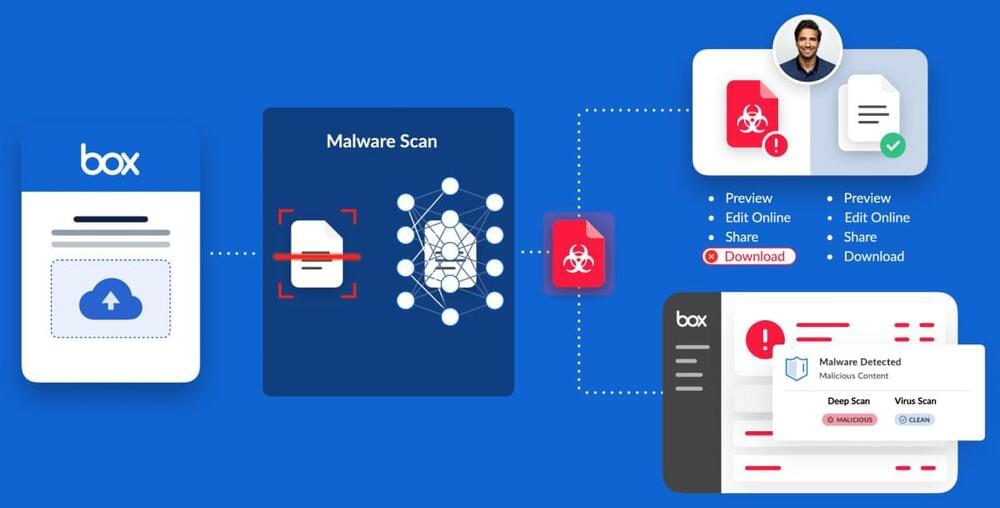Archive for the ‘cybercrime/malcode’ category: Page 112
Oct 18, 2021
CISA Issues Warning On Cyber Threats Targeting Water and Wastewater Systems
Posted by Saúl Morales Rodriguéz in category: cybercrime/malcode
The U.S. Cybersecurity Infrastructure and Security Agency (CISA) issues a warning about cyber threats targeting wastewater and water systems.
Oct 18, 2021
VirusTotal Releases Ransomware Report Based on Analysis of 80 Million Samples
Posted by Saúl Morales Rodriguéz in category: cybercrime/malcode
As many as 130 different ransomware families have been found to be active in 2020 and the first half of 2,021 with Israel, South Korea, Vietnam, China, Singapore, India, Kazakhstan, Philippines, Iran, and the U.K. emerging as the most affected territories, a comprehensive analysis of 80 million ransomware-related samples has revealed.
Google’s cybersecurity arm VirusTotal attributed a significant chunk of the activity to the GandCrab ransomware-as-a-service (RaaS) group (78.5%), followed by Babuk (7.61%), Cerber (3.11%), Matsnu (2.63%), Wannacry (2.41%), Congur (1.52%), Locky (1.29%), Teslacrypt (1.12%), Rkor (1.11%), and Reveon (0.70%).
Oct 15, 2021
US links $5.2 billion worth of Bitcoin transactions to ransomware
Posted by Genevieve Klien in categories: bitcoin, cybercrime/malcode, finance
The U.S. Treasury Department’s Financial Crimes Enforcement Network (FinCEN) has identified roughly $5.2 billion worth of outgoing Bitcoin transactions likely tied to the top 10 most commonly reported ransomware variants.
FinCEN identified 177 CVC (convertible virtual currency) wallet addresses used for ransomware-related payments after analyzing 2,184 SARs (Suspicious Activity Reports) filed between January 1 2011, and June 30 2021, and reflecting $1.56 billion in suspicious activity.
Based on blockchain analysis of transactions tied to the 177 CVC wallets, FinCEN identified roughly $5.2 billion in outgoing BTC transactions potentially tied to ransomware payments.
Oct 14, 2021
Homeland Security Warns of Cyberattacks Intended to Kill People
Posted by Shane Hinshaw in category: cybercrime/malcode
Oct 8, 2021
Researchers create ‘self-aware’ algorithm to ward off hacking attempts
Posted by Quinn Sena in categories: biotech/medical, cybercrime/malcode, information science, nuclear energy, robotics/AI
It sounds like a scene from a spy thriller. An attacker gets through the IT defenses of a nuclear power plant and feeds it fake, realistic data, tricking its computer systems and personnel into thinking operations are normal. The attacker then disrupts the function of key plant machinery, causing it to misperform or break down. By the time system operators realize they’ve been duped, it’s too late, with catastrophic results.
The scenario isn’t fictional; it happened in 2,010 when the Stuxnet virus was used to damage nuclear centrifuges in Iran. And as ransomware and other cyberattacks around the world increase, system operators worry more about these sophisticated “false data injection” strikes. In the wrong hands, the computer models and data analytics—based on artificial intelligence—that ensure smooth operation of today’s electric grids, manufacturing facilities, and power plants could be turned against themselves.
Purdue University’s Hany Abdel-Khalik has come up with a powerful response: To make the computer models that run these cyberphysical systems both self-aware and self-healing. Using the background noise within these systems’ data streams, Abdel-Khalik and his students embed invisible, ever-changing, one-time-use signals that turn passive components into active watchers. Even if an attacker is armed with a perfect duplicate of a system’s model, any attempt to introduce falsified data will be immediately detected and rejected by the system itself, requiring no human response.
Oct 8, 2021
How AI can fight human trafficking
Posted by Gemechu Taye in categories: cybercrime/malcode, robotics/AI
There are 40.3 million victims of human trafficking globally, according to the International Labor Organization. Marinus Analytics, a startup based in Pittsburgh, Pennsylvania, hopes to make a dent in that number. The company’s mission is to “serve those working on the frontlines of public safety by developing technology for them to disrupt human trafficking, child abuse, and cyber fraud.” For its achievements, Marinus won $500,000 as part of its third-place ranking in the 2021 IBM Watson AI XPRIZE competition. The startup is the brainchild of three co-founders: Cara Jones, Emily Kennedy, and Artur Dubrawski, who launched it out of the Robotics Institute at Carnegie Mellon University in 2014.
Marinus implements its mission primarily through its set of AI-based tools called Traffic Jam, whose goal is “to find missing persons, stop human trafficking and fight organized crime.”
Traditionally, finding a missing person would involve taping a picture of the person on the computer and then manually combing through thousands, if not millions, of online ads on adult services websites to see if any of the posted pictures match. Such a process is time-consuming and tiring. A human detective’s attention can start flagging after long hours at the computer doing the same task endlessly.
Oct 6, 2021
Report: Twitch Is Hacked And Its Source Code Is In The Wild [Update]
Posted by Quinn Sena in categories: cybercrime/malcode, robotics/AI
Autonomous machine expected to pick more than 25,000 raspberries a day, outpacing human workers.
Oct 6, 2021
Box taps deep learning to detect sophisticated malware
Posted by Saúl Morales Rodriguéz in categories: cybercrime/malcode, robotics/AI
Cloud-based content management provider Box has announced a new “deep scan” functionality that checks files as they are uploaded to identify sophisticated malware and avert attacks.
The new capabilities constitute part of Box Shield, which uses machine learning to prevent data leaks, detect threats, and spot any kind of abnormal behavior. In April of last year, Box added a slew of automated malware detection features to the mix, allowing Box Shield customers to spot malicious content that may already have been uploaded to a Box account. However, so far this has leaned heavily on “known” threats from external intelligence databases. Moving forward, Box said it will mesh deep learning technology with external threat intelligence capabilities to analyze files for malicious scripts, macros, and executables to protect companies from zero-day (unknown) vulnerabilities.
When a user uploads an infected file, Box will quarantine it for inspection but will still allow the user to view a preview of the file and continue working.
Oct 6, 2021
Cybereason: Remote access Trojan targeted telecomms and aerospace
Posted by Saúl Morales Rodriguéz in category: cybercrime/malcode
These attacks were perpetrated by a newly discovered Iranian state sponsored threat group — dubbed MalKamak — that has been operating under the radar since at least 2018.
This operation has been ongoing for years, continuously evolving its malware year after year, while successfully evading most security tools. The authors of ShellClient invested a lot of effort into making it stealthy to evade detection by antivirus and other security tools by leveraging multiple obfuscation techniques and recently implementing a Dropbox client for command and control (C2), making it very hard to detect. By studying the ShellClient development cycles, Cybereason researchers were able to observe how ShellClient has morphed over time from a rather simple reverse shell to a sophisticated RAT used to facilitate cyber espionage operations.
The most recent ShellClient versions observed in Operation GhostShell follow the trend of abusing cloud-based storage services — in this case, the popular Dropbox service. The ShellClient authors used Dropbox to exfiltrate the stolen data and send commands to the malware. Threat actors have increasingly adopted this tactic due to its simplicity and the ability to effectively blend in with legitimate network traffic. Ultimately, this discovery tells researchers a lot about the tactics that advanced attackers are using to defeat security solutions.

















